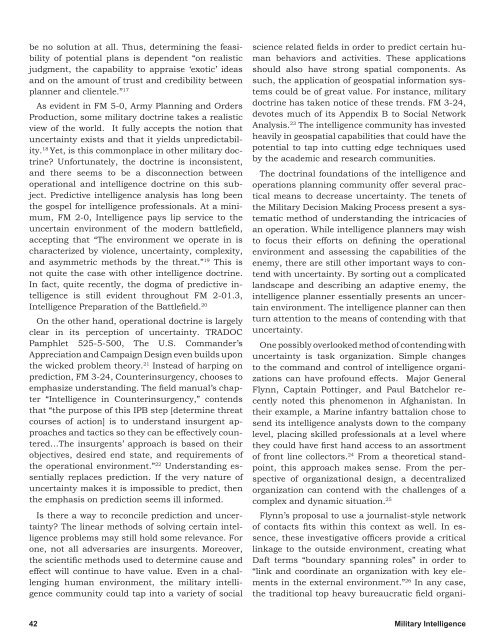George w. casey jr. - Federation of American Scientists
George w. casey jr. - Federation of American Scientists
George w. casey jr. - Federation of American Scientists
You also want an ePaper? Increase the reach of your titles
YUMPU automatically turns print PDFs into web optimized ePapers that Google loves.
e no solution at all. Thus, determining the feasibility<br />
<strong>of</strong> potential plans is dependent “on realistic<br />
judgment, the capability to appraise ‘exotic’ ideas<br />
and on the amount <strong>of</strong> trust and credibility between<br />
planner and clientele.” 17<br />
As evident in FM 5-0, Army Planning and Orders<br />
Production, some military doctrine takes a realistic<br />
view <strong>of</strong> the world. It fully accepts the notion that<br />
uncertainty exists and that it yields unpredictability.<br />
18 Yet, is this commonplace in other military doctrine?<br />
Unfortunately, the doctrine is inconsistent,<br />
and there seems to be a disconnection between<br />
operational and intelligence doctrine on this subject.<br />
Predictive intelligence analysis has long been<br />
the gospel for intelligence pr<strong>of</strong>essionals. At a minimum,<br />
FM 2-0, Intelligence pays lip service to the<br />
uncertain environment <strong>of</strong> the modern battlefield,<br />
accepting that “The environment we operate in is<br />
characterized by violence, uncertainty, complexity,<br />
and asymmetric methods by the threat.” 19 This is<br />
not quite the case with other intelligence doctrine.<br />
In fact, quite recently, the dogma <strong>of</strong> predictive intelligence<br />
is still evident throughout FM 2-01.3,<br />
Intelligence Preparation <strong>of</strong> the Battlefield. 20<br />
On the other hand, operational doctrine is largely<br />
clear in its perception <strong>of</strong> uncertainty. TRADOC<br />
Pamphlet 525-5-500, The U.S. Commander’s<br />
Appreciation and Campaign Design even builds upon<br />
the wicked problem theory. 21 Instead <strong>of</strong> harping on<br />
prediction, FM 3-24, Counterinsurgency, chooses to<br />
emphasize understanding. The field manual’s chapter<br />
“Intelligence in Counterinsurgency,” contends<br />
that “the purpose <strong>of</strong> this IPB step [determine threat<br />
courses <strong>of</strong> action] is to understand insurgent approaches<br />
and tactics so they can be effectively countered…The<br />
insurgents’ approach is based on their<br />
objectives, desired end state, and requirements <strong>of</strong><br />
the operational environment.” 22 Understanding essentially<br />
replaces prediction. If the very nature <strong>of</strong><br />
uncertainty makes it is impossible to predict, then<br />
the emphasis on prediction seems ill informed.<br />
Is there a way to reconcile prediction and uncertainty?<br />
The linear methods <strong>of</strong> solving certain intelligence<br />
problems may still hold some relevance. For<br />
one, not all adversaries are insurgents. Moreover,<br />
the scientific methods used to determine cause and<br />
effect will continue to have value. Even in a challenging<br />
human environment, the military intelligence<br />
community could tap into a variety <strong>of</strong> social<br />
science related fields in order to predict certain human<br />
behaviors and activities. These applications<br />
should also have strong spatial components. As<br />
such, the application <strong>of</strong> geospatial information systems<br />
could be <strong>of</strong> great value. For instance, military<br />
doctrine has taken notice <strong>of</strong> these trends. FM 3-24,<br />
devotes much <strong>of</strong> its Appendix B to Social Network<br />
Analysis. 23 The intelligence community has invested<br />
heavily in geospatial capabilities that could have the<br />
potential to tap into cutting edge techniques used<br />
by the academic and research communities.<br />
The doctrinal foundations <strong>of</strong> the intelligence and<br />
operations planning community <strong>of</strong>fer several practical<br />
means to decrease uncertainty. The tenets <strong>of</strong><br />
the Military Decision Making Process present a systematic<br />
method <strong>of</strong> understanding the intricacies <strong>of</strong><br />
an operation. While intelligence planners may wish<br />
to focus their efforts on defining the operational<br />
environment and assessing the capabilities <strong>of</strong> the<br />
enemy, there are still other important ways to contend<br />
with uncertainty. By sorting out a complicated<br />
landscape and describing an adaptive enemy, the<br />
intelligence planner essentially presents an uncertain<br />
environment. The intelligence planner can then<br />
turn attention to the means <strong>of</strong> contending with that<br />
uncertainty.<br />
One possibly overlooked method <strong>of</strong> contending with<br />
uncertainty is task organization. Simple changes<br />
to the command and control <strong>of</strong> intelligence organizations<br />
can have pr<strong>of</strong>ound effects. Major General<br />
Flynn, Captain Pottinger, and Paul Batchelor recently<br />
noted this phenomenon in Afghanistan. In<br />
their example, a Marine infantry battalion chose to<br />
send its intelligence analysts down to the company<br />
level, placing skilled pr<strong>of</strong>essionals at a level where<br />
they could have first hand access to an assortment<br />
<strong>of</strong> front line collectors. 24 From a theoretical standpoint,<br />
this approach makes sense. From the perspective<br />
<strong>of</strong> organizational design, a decentralized<br />
organization can contend with the challenges <strong>of</strong> a<br />
complex and dynamic situation. 25<br />
Flynn’s proposal to use a journalist-style network<br />
<strong>of</strong> contacts fits within this context as well. In essence,<br />
these investigative <strong>of</strong>ficers provide a critical<br />
linkage to the outside environment, creating what<br />
Daft terms “boundary spanning roles” in order to<br />
“link and coordinate an organization with key elements<br />
in the external environment.” 26 In any case,<br />
the traditional top heavy bureaucratic field organi-<br />
42 Military Intelligence















